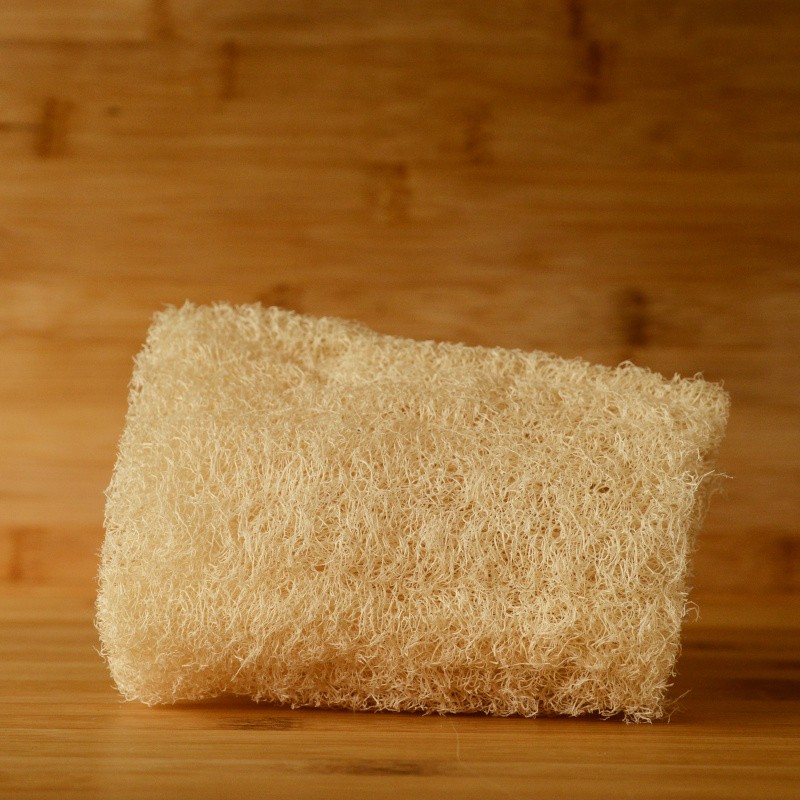




Luffa bath sponge.
Natural vegetable sponge in Luffa for the bath or the shower for the massage of the body and the exfoliation of the dead skins.
100% natural vegetable fiber / 100% biodegradableLife span of
about 4 to 6 months depending on use.
The sponges we have selected are grown without pesticides in sustainable plantations in Galicia (Spain). They are produced in a traditional way and cleaned with spring water (no use of chlorine or hydrogen peroxide). Our supplier, Iberluffa, has developed its own variety of Luffa which allows it to obtain different fibre intensities and to offer adapted products (face peeling / 'normal' or 'soft' bath sponge etc).
Common name: vegetable sponge, Luffa sponge, loofah, Loufah, sponge gourd, hammam gourd...
Scientific name: LUFFA CILINDRICA, of the family CUCURBITACEAE
The Luffa is a vegetable, more precisely a squash which, peeled, dried and washed constitutes a sponge with soft exfoliating properties. The Luffa sponge is widely used in ayurvedic and hammam treatments.
Unlike synthetic sponges (made from petroleum derivatives), the Luffa is a natural fiber sponge and leaves no harmful residue on the skin.
Stimulates blood circulationPrevents
cellulite
Reduces blackheads
Prevents ingrown hairs
Removes dead skin
Respects your skin
100% natural 100% biodegradable
Resists over time
Shower / bath: (raw or shaped sponge
)The sponge is used as a gentle exfoliator.
Wet your loofah under warm water. The wetter the loofah, the softer the exfoliation.
Apply soap or shower gel to the loofah and wash it off with small circular motions to remove dead skin.
You can use the loofah daily. Be gentle but firm.
Sensitive skin can opt for gentle versions of the Luffa and/or use 2-3 times a week.
Facial peeling: (shaped disc)
The facial peeling is performed once or twice a week. Small discs of soft loofah fibers are sewn together.
Wet the loofah well and soften it with warm water, apply soap and gently rub your face with small circular movements. Rinse well and dry your face with a towel then apply your skin care cream or oil to moisturize your skin.
Household uses:
Due to its gentle abrasive properties, Luffa does not scratch. It can be used for cleaning, washing dishes, car....
Luffa is a natural, organic product. Our Luffa is grown without pesticides and mechanically cleaned with spring water.
You like natural, healthy products; well, so do the bacteria. Their preferred environment combining heat and humidity (like a bathroom for example...) some basic rules of hygiene are necessary to ensure the conservation and longevity of your Luffa.*
- After each use, the Luffa must be rinsed with hot water and dried properly to rid it of the dead skin it has just exfoliated from your epidermis. Make sure that the rinse removes any soap residue and hang it up to dry.
- Wash your loofah regularly in the washing machine (laundry or dishes) or by putting it on the stove in a pan of water. You don't have to boil the water and you can add a little baking soda or vinegar. We recommend disinfecting it once a week.
- You can also put it in the microwave (2 minutes) but unlike machine washing, your loofah will not be washed and free of impurities.
- The Luffa must be dried in the open air. Do not put it in a tumble dryer. The fibres would be damaged and it would shrink like wool
- The lifespan of our Luffa is from 4 to 6 months depending on the use and maintenance. The Luffa being natural and 100% biodegradable you can put it in the compost.
*Please note that the hygiene rules stated here apply to all bath items such as sponges or bath flowers whether they are synthetic or natural. Bacteria like wet and warm environments so, whether you use a Luffa or a synthetic flower, it is important to rinse well and let your bathroom item dry.